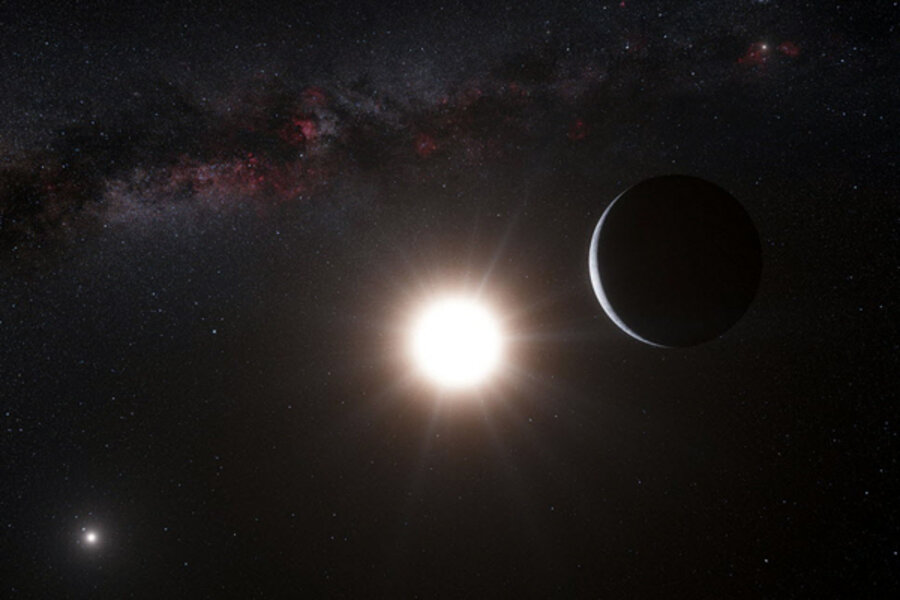Earth-size planet found just next door, in Alpha Centauri system
Loading...
Astronomers have discovered a rocky, Earth-mass planet right in our own sun’s galactic neighborhood. The planet is orbiting a star a mere 4.4 light-years away in the multiple-star Alpha Centauri system, which may well turn out to be a cosmic condo, hosting additional planets.
A habitable planet could well be among them, some astronomers speculate.
The planet, with an estimated mass 1.13 times higher than Earth's, is orbiting Alpha Centauri B, which forms a binary pair with Alpha Centauri A. Both essentially share the sun's mass and are only slightly older than the sun. The system includes a smaller, dimmer star called Proxima Centauri.
With a "year" that corresponds to 3.2 Earth days, the newfound planet is too close to the star to be habitable, notes Xavier Dumusque, a PhD student in astrophysics at the University of Porto in Portugal. He led the team reporting the discovery in Thursday's issue of the journal Nature.
The planet is gravitationally bound to the star in such a way that it presents the same face to Alpha Centauri B all the time. This sets up temperatures on the day side that could top 2,200 degrees Fahrenheit, melting rock – a sharp contrast with the night side, perpetually facing the cold of space.
Still, researchers point out that rocky planets tend to have siblings.
Evidence from 17 years of hunting planets, especially evidence that NASA's Kepler spacecraft is amassing, "shows us where there's one rocky planet, there's more," says Debra Fischer, a Yale University astronomer who has been deeply involved in hunting for extrasolar planets for most of this period.
Snagging a rocky planet with an Earth-like mass one solar system over from ours suggests that "it's a good bet there are other planets there as well," she adds, including planets orbiting Alpha Centauri A.
Detecting an Earth-mass, rocky planet in the habitable zone of either star will be extremely difficult. The notion that one of these lies a cosmically scant 4 light-years away remains speculation, but "it is not a crazy speculation anymore," says Dr. Fischer, who was not part of the research team reporting the results.
The team, which included 11 researchers from Switzerland, Portugal, and France, used the European Southern Observatory's 3.6-meter telescope high in the Chilean desert.
The researchers observed the system on and off for four years using an approach that measures the slight to-and-fro tug a planet imparts to its host star as the planet orbits. Using a highly stable spectrograph bolted to the back of the telescope, the team detected this movement as subtle changes in the star's spectrum – which shifted toward red when the planet tugged the star away from Earth, and to blue when it pulled the star toward observers.
The effect was tiny, amounting to a change in the star’s velocity of about 1 mile an hour as the planet tugged it back and forth. Indeed, the planet orbiting Alpha Centauri B represents the lightest planet yet found using this "radial velocity" detection approach. The achievement required an intimate knowledge of the star's behavior – tracking periods of increased and decreased star-spot activity on the surface, which can trigger changes in the star's spectrum that can be mistaken for planet-induced changes.
For Alpha Centauri B, those faux changes are far larger than the planet's effect, requiring sophisticated computer models to filter out the star's natural spectral shifts.
This has prompted some researchers to dub the discovery a "planet candidate" until other teams used their own models of the star's behavior, combined with the European data, to try to confirm the discovery.
Even better would be additional, independent observations that confirm the results, notes Artie Hatzes, an astronomer at the University of Jena in Germany and another planet hunter.
The spectrograph the European team used is the best at what it does, Dr. Hatzes notes in an e-mail exchange. Still, he says, other, less-capable instruments could be used if they spent more time than the Europeans did making observations.
Meanwhile, Fischer is leading a team that has been observing the system as well, but over a shorter time. Using a 1.5-meter telescope at the Cerro Tololo Inter-American Observatory, also in Chile, her team has recently added a souped-up spectrograph to the telescope and began using it in June – improving one avenue for confirmation.
Still, the quality and quantity of the European team's data is "quite extraordinary," says Greg Laughlin, an astronomer at the University of California at Santa Cruz and another extrasolar-planet researcher.
If this planet had been discovered in any system other than Alpha Centauri, "this object would have been completely run-of-the-mill," Dr. Laughlin says.
But the prospect of finding more planets – and especially if one turns out to be the Holy Grail, an Earth-like planet in a habitable zone – could lead to humanity's first mission to another planetary system.
Current rocket engines won't cut it, he notes, adding that at the travel speeds current technologies can achieve, it would take 40,000 years to drop in on the solar system's nearest neighbor.
If, however, planet hunters find a potentially habitable planet in the Alpha Centauri system, "you might see a groundswell of excitement to look at new kinds of propulsion technologies" that would allow a robotic mission to reach the planet within a human lifetime.
"It really comes down to what the [planetary] inventory of these stars looks like," he says.





